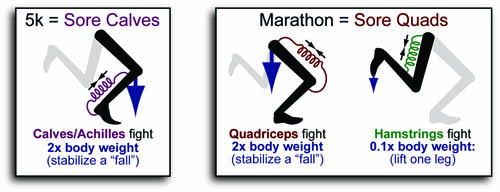Have you ever wondered why your calves are sore after a 5k but your hamstrings are sore after a marathon? The reason is your calves bear more of your weight as you run shorter/faster and your quadriceps bear more of your weight as you run longer/slower.
THE “IMPACT” OF RUNNING FAST:
When you run fast, you naturally begin to land more on the fore of your foot as pictured in the figure above. When your foot is in contact with the ground, your calf and gravity directly fight each other where your calf pulls your heal out and gravity trys to collapse your heal down. The total force of gravity is usually greater than your total weight due to a fall from the airborne phase of the running cycle. The reason the calf is the preferred muscle for running fast is because of the unique ability of the achilles tendon (which connects the calf to the bottom of the foot) to conserve about 30% of the impact energy and use it to propell you forward in a manner identical to the spring in a pogo stick!
THE “IMPACT” OF RUNNING SLOW:
On the other hand, for longer distance running, the hamstrings have higher have muscle fiber number and energy stores necessary endure your weight for a long journey. As such, when you run more slowly, you begin to land more on the back of your foot as pictured in the figure above. In this “impact stance”, your quadricep and gravity directly fight each other where your quadricep pulls your torso up while gravity trys to pull it down. While your quadriceps must support your total “landing weight” your hamstrings only have to support “one leg” due to the fact they are active in the “swing phase” of the runners gait.
WHY “IMPACT” CAUSES MUSCLE DAMAGE:
Now it is not the greater force, per se, that causes the muscle damage that results in the soreness of the calves or quads. Rather as can be seen in the figure above, the effect of a greater force (landing impact) on these muscle groups causes the fibers within the muscle to be dragged away from each other in what’s known as an eccentric contraction. Muscle-fibers are built to “pull” only and so this dragging can be very destructive. Conversely, concentric contractions result when the force generated by the muscle is much greater than the force that resists it. This type of contraction involves a greater percentage of muscle fibers’s pulling (as they are built to) and so less damage results.
REFERENCES:
- McMahon, T. J. Exp. Biol 1985,282, 263-282
- McMahon, T. J. Biomechanics 1978,12, 893-904
- McMahon, T. J. Exp. Biol 1985,282, 263-282
- Boron, W.F.; Boulpaep, E.L. Medical Physiology, 2nd ed. 2011 Saunders
- Noakes, T. Lore of Running 4th ed. 2001 Human Kinetics. Champaign, IL.
- Martin, D.E.; Coe, P.N. Better Training for Distance Runners 2nd ed 1997 Human Kinetics. Champaign, IL
- Puleo, J.; Milroy, P. Running Anatomy 2010 Human Kinetics. Champaign, IL

This work by Eugene Douglass and Chad Miller is licensed under a Creative Commons Attribution-NonCommercial-ShareAlike 3.0 Unported License.


